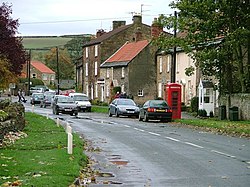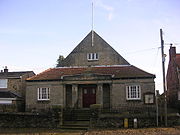Gilling West
| Gilling West | |
| Yorkshire North Riding | |
|---|---|
 Gilling West | |
| Location | |
| Grid reference: | NZ183050 |
| Location: | 54°26’27"N, 1°43’9"W |
| Data | |
| Population: | 534 (2011) |
| Post town: | Richmond |
| Postcode: | DL10 |
| Local Government | |
| Council: | North Yorkshire |
Gilling West is a village in the North Riding of Yorkshire, standing about three and a half miles north of Richmond in the ancient liberty of Richmondshire. Its name has the suffix "West" to distinguish it from Gilling East, also in the North Riding, some 32 miles away.
A 2018 report states that the community houses people who commute to Darlington and other Teesside towns and to Richmond. The village retains a village hall, two public houses and a shop but there is no longer a post office. The village is a conservation area, and substantial percentage of the buildings are listed buildings.[1][2]
History
Gilling appears in the Domesday Book of 1086 under the name of Ghellinges "in the hundred of Land of Count Alan" as a tiny village with "16 villagers. 3 freemen. 6 smallholders". The tenant-in-chief was named Count Alan of Brittany.[3]
Parish church
The parish church, St Agatha possibly has some late Anglo-Saxon material. The Domesday Book of 1086 records a place of worship in the village as of 1086, and it is said that parts of St Agatha's date back to this period.
The church was subsequently restored and modified in 1845. The church this is recorded as being of th late 11th century, with work fro the early 14th and late 14the cetury, and of the late 15th century, and of the Victorian restoration. The church is a Grade I listed building.[4][5] An archeological report in 2018 noted a number of pre-Conquest carved stones and a mediæval grave cover, and that the west tower probably belonged to the church recorded in Domesday.
St Agatha's contains a monument to Rear-Admiral Sir Christopher Cradock (1862-1914), who was born in the parish, at Hartforth.[6]
History
In earlier times, the area was one of some importance in the Anglo-Saxon period of British history. In the 7th century it was a seat of the Kingdom of Deira, and from the 9th century, the surrounding area known as Gillingshire.[7] One report records findngs of a 9th century Anglican cross, a 10th century hogback tombs and a Viking sword: the latter was found by a boy palying in the beck: a double-edged, iron-bladed sword with a silver-decorated handle, dating from the 9th century. The restored Gilling sword is in the collection of the Yorkshire Museum in York.[8]
The area had a number of quarries that were used until the mid 1800s for stone used in construction. One survives, the Dunsa Bank Quarry. The manor house Sedbury Hall, on the edge of the village, was described by one historical report as "the seat of the lords of Sedbury Manor" as of 1914. Formerly associated with the Darcy, Aske, Conyers and Nevil families,[9] it is now home to the Baker Baker family (formerly of Elemore Hall, Pittington, County Durham).[10] The present house was designed by John Carr, and its grounds were laid out in the 18th century by William Sawrey Gilpin.[11]
Gilling Lodge, a Grade II listed building, was constructed in the mid 1800s for the Roper family, according to the listing.[12]
Community
The village has two pubs, the Angel Inn and the White Swan, and had a post office/village shop until its closure in 2013.
Outside links
| ("Wikimedia Commons" has material about Gilling West) |
References
- ↑ "Conservation Area Appraisal". https://www.richmondshire.gov.uk/media/8994/adopted-gilling-west-conservation-area-appraisal-web.pdf. Retrieved 6 February 2021.
- ↑ "Listed Buildings in Gilling with Hartforth and Sedbury, Richmondshire, North Yorkshire". https://britishlistedbuildings.co.uk/england/gilling-with-hartforth-and-sedbury-richmondshire-north-yorkshire.
- ↑ Gilling West in the Domesday Book
- ↑ "Gilling: St Agatha". https://www.achurchnearyou.com/church/3208/about-us/.
- ↑ National Heritage List 1316927: Church of St Agatha, Gilling West (Grade I listing)
- ↑ Webster, Dave (2009-01-03). "Gilling West Cradock monument". https://www.flickr.com/photos/davewebster14/3164697292/.
- ↑ "Village History". http://www.gillingwest.org.uk/7.html. Retrieved 14 June 2013.
- ↑ "Collections Highlights: The Gilling Sword". Yorkshire Museum. https://www.yorkshiremuseum.org.uk/collections/collections-highlights/the-gilling-sword/. Retrieved 5 October 2018.
- ↑ A History of the County of York: North Riding - Volume 1 pp 71-84: Parishes: Gilling (Victoria County History)
- ↑ "Baker Baker papers: Durham University Archives". https://archiveshub.jisc.ac.uk/search/archives/7f9250b1-13bd-3c2f-9478-f52e503ea4e4. Retrieved 15 May 2018.
- ↑ "Sedbury Hall, Richmond, Giling West, near Richmond, Yorkshire, England". http://www.parksandgardens.org/places-and-people/site/2933. Retrieved 15 May 2018.
- ↑ National Heritage List 1166425: Gilling Lodge (Grade II listing)


